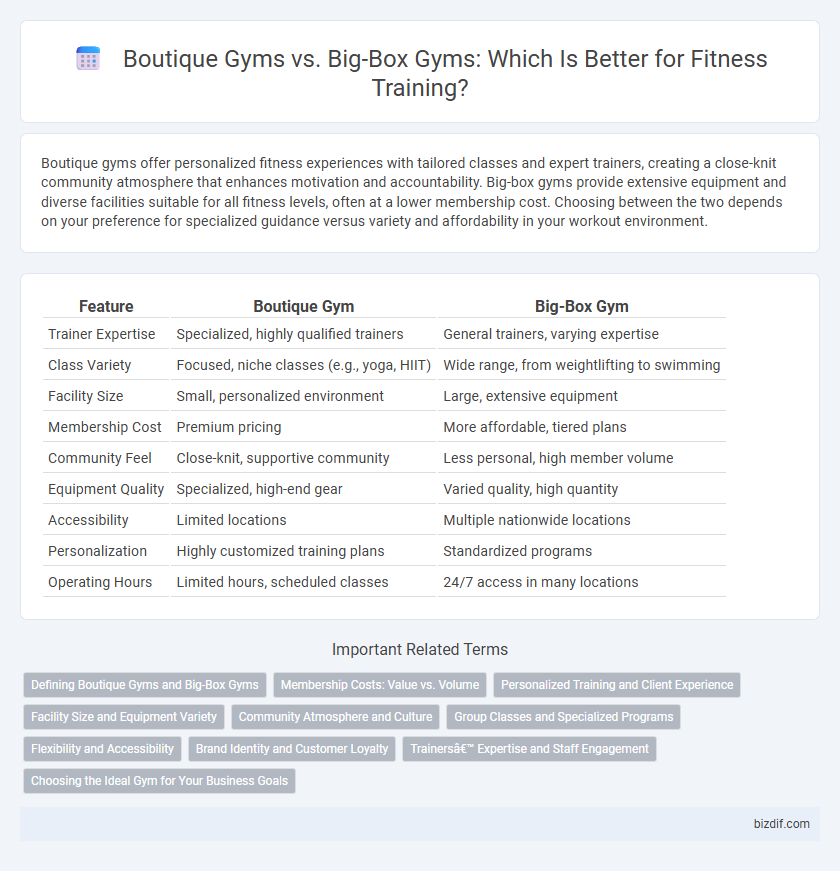Boutique gyms offer personalized fitness experiences with tailored classes and expert trainers, creating a close-knit community atmosphere that enhances motivation and accountability. Big-box gyms provide extensive equipment and diverse facilities suitable for all fitness levels, often at a lower membership cost. Choosing between the two depends on your preference for specialized guidance versus variety and affordability in your workout environment.
Table of Comparison
| Feature | Boutique Gym | Big-Box Gym |
|---|---|---|
| Trainer Expertise | Specialized, highly qualified trainers | General trainers, varying expertise |
| Class Variety | Focused, niche classes (e.g., yoga, HIIT) | Wide range, from weightlifting to swimming |
| Facility Size | Small, personalized environment | Large, extensive equipment |
| Membership Cost | Premium pricing | More affordable, tiered plans |
| Community Feel | Close-knit, supportive community | Less personal, high member volume |
| Equipment Quality | Specialized, high-end gear | Varied quality, high quantity |
| Accessibility | Limited locations | Multiple nationwide locations |
| Personalization | Highly customized training plans | Standardized programs |
| Operating Hours | Limited hours, scheduled classes | 24/7 access in many locations |
Defining Boutique Gyms and Big-Box Gyms
Boutique gyms specialize in personalized fitness experiences with small class sizes, expert trainers, and niche workout styles such as yoga, Pilates, or HIIT, fostering a strong community atmosphere. Big-box gyms offer extensive facilities that include a wide range of equipment, multiple group classes, and amenities like pools and saunas, catering to high-volume memberships with a lower cost structure. The key distinction lies in boutique gyms emphasizing tailored, intensive coaching and environment, while big-box gyms prioritize broad accessibility and comprehensive fitness resources.
Membership Costs: Value vs. Volume
Boutique gyms typically offer specialized fitness classes and personalized training at higher membership costs, prioritizing quality and individualized attention over mass enrollment. Big-box gyms provide lower membership fees by leveraging large membership volumes, giving access to extensive equipment and amenities but often at the expense of personalized services. Evaluating the cost-effectiveness depends on fitness goals, with boutique gyms offering targeted programs and big-box gyms appealing to budget-conscious members seeking variety.
Personalized Training and Client Experience
Boutique gyms offer highly personalized training programs tailored to individual goals, leveraging smaller class sizes and expert trainers to deliver focused attention and customized workout plans. Big-box gyms provide a broader range of equipment and amenities but often lack the individualized coaching and community atmosphere critical for personalized client experiences. Members at boutique gyms frequently report higher satisfaction due to the close-knit environment and dedicated support that enhance motivation and fitness outcomes.
Facility Size and Equipment Variety
Boutique gyms typically offer a compact facility size with specialized, high-quality equipment tailored to specific fitness disciplines such as yoga, pilates, or HIIT, ensuring a focused workout environment. Big-box gyms boast expansive spaces filled with a vast array of equipment, including extensive free weights, cardio machines, and multifunctional training zones designed to accommodate diverse fitness routines. Choosing between the two depends on preferences for personalized, niche workouts versus access to comprehensive equipment and space variety.
Community Atmosphere and Culture
Boutique gyms foster a tight-knit community atmosphere by providing personalized attention and tailored fitness programs, creating strong social bonds among members. Big-box gyms often emphasize scale and variety of equipment but may lack the intimate culture that encourages member interaction and support. Members at boutique gyms typically experience higher motivation and accountability due to the supportive and engaging environment.
Group Classes and Specialized Programs
Boutique gyms offer highly personalized group classes and specialized programs tailored to specific fitness goals, such as yoga, Pilates, HIIT, or strength training, fostering a close-knit community atmosphere. Big-box gyms provide a wider variety of group classes and programs on a larger scale, often with more scheduling options but less individualized attention. The choice between boutique and big-box gyms depends on preferences for personalized instruction versus diverse class availability and flexible hours.
Flexibility and Accessibility
Boutique gyms offer personalized workout plans and flexible class schedules tailored to individual needs, enhancing accessibility for members seeking specialized training. Big-box gyms provide extensive operating hours and multiple locations, allowing users convenient access and the ability to work out at various times. Both models deliver distinct advantages in flexibility and accessibility depending on user preferences and lifestyle demands.
Brand Identity and Customer Loyalty
Boutique gyms cultivate a strong brand identity through personalized services and niche fitness programs, fostering deeper emotional connections with members and enhancing customer loyalty. Big-box gyms leverage their extensive facilities and widespread brand recognition, attracting a large and diverse customer base but often facing challenges in maintaining individual member engagement. The tailored experience at boutique gyms typically results in higher retention rates compared to the more generalized approach of big-box gyms.
Trainers’ Expertise and Staff Engagement
Boutique gyms often employ highly specialized trainers with certifications in niche fitness areas, ensuring personalized coaching and tailored programs. Big-box gyms typically have a larger staff with varied expertise but may lack the consistent, individualized attention found in boutique settings. Staff engagement in boutique gyms tends to be more proactive and relationship-driven, fostering motivation and accountability among members.
Choosing the Ideal Gym for Your Business Goals
Boutique gyms offer specialized fitness programs, personalized training, and a community-driven atmosphere, which can enhance client retention and cater to niche markets such as high-intensity interval training or yoga. Big-box gyms provide expansive facilities, diverse equipment, and lower membership costs, appealing to a broad demographic and supporting high-volume business models. Selecting the ideal gym depends on your target clientele, business goals, and desired brand positioning within the competitive fitness industry.
Boutique gym vs Big-box gym Infographic

 bizdif.com
bizdif.com